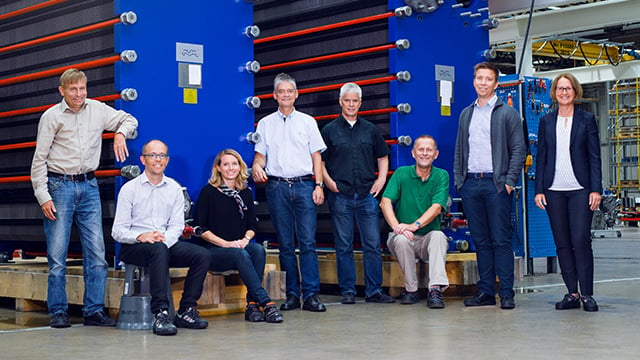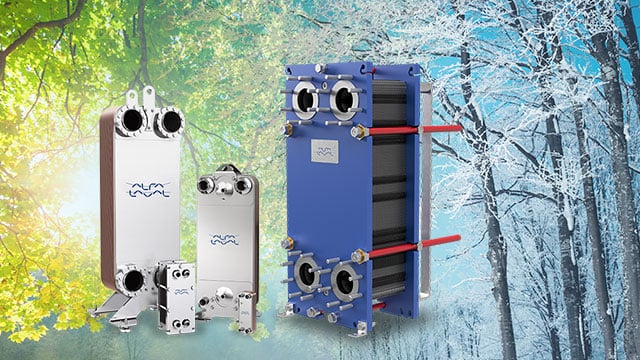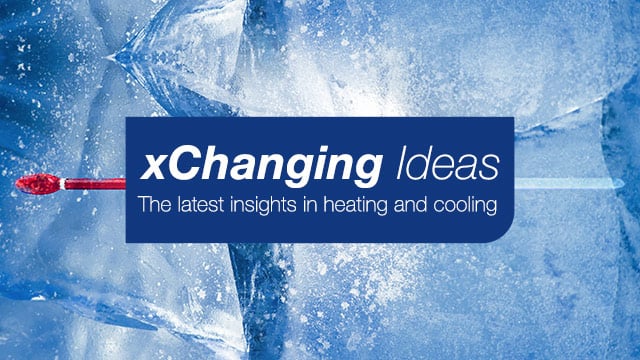HVAC cooling
Planning a cooling system can be a complex task, considering the many factors involved in a successful solution. Alfa Laval supplies a comprehensive range of high-quality heat exchangers and components for cooling applications, and applies knowledge and experience gained from numerous completed projects around the world.
Reduce energy consumption and carbon footprint
- Industry leading portfolio of gasketed and brazed plate heat exchangers
- Patented product features ensure highest performance
- Easy to install and maintain
- AHRI certified models available
Many HVAC applications require gasketed plate heat exchangers in cooling systems, air conditioning and heat recovery systems. Air conditioning systems contain at least two heat exchangers, usually called the condenser and the evaporator. The plate heat exchangers indirectly connect chillers, boilers and cooling towers to central plant systems. Plate heat exchangers also reduce the cooling load on the chillers when used in economiser circuits and heat recovery circuits. Choosing the correctly sized and configured plate heat exchanger for your system has a direct impact on performance and energy savings.
Comprehensive range, reliable performance
Most cooling solutions involve one or more heat exchangers. Alfa Laval identifies a solution for specific cooling needs, customised from our comprehensive heat exchanger range. Our performance-certified heat exchangers ensure reliable performance.
Solutions that perform under pressure
Alfa Laval provides solutions for major building and construction projects such as climate control and air conditioning in high rises and office towers. Large volumes of water must be pumped over great distances at constant high pressure through tall buildings. Alfa Laval’s complete cooling portfolio for tall buildings includes heat exchangers in a pressure-breaking role to protect chillers and air conditioning units from excessive pressure.
The business case for energy efficiency
There is a strong business case for investing in heating, ventilation and air conditioning (HVAC) energy efficiency. According to the U.S. Department of Energy (DOE), HVAC systems typically account for as much as 30% of energy use and costs in commercial buildings and office spaces. Plate heat exchangers are a key equipment component to save energy and improve a building's sustainability and carbon footprint.
The hidden cost of non-certified plate heat exchangers in your cooling plant
HVAC systems typically account for as much as 30% of energy use and costs in commercial buildings and office spaces. Plate heat exchangers are a key equipment component to save energy and improve a building's sustainability and carbon footprint.
Chiller evaporator
Due to an undersurfaced plate heat exchanger, if the fan coils received 1°C higher cooling temperature, the chiller evaporation temperature will be lower, causing a higher lift.
- 3.5% higher chiller energy consumption
Chiller condenser
Due to an undersurfaced plate heat exchanger, if the chiller condenser receives 1°C higher cooling source, the condensation temperature will increase, causing a higher lift.
- 1.5% higher chiller energy consumption
The Air-Conditioning, Heating, and Refrigeration Institute (AHRI) Product Performance Certification Programme is a voluntary programme, administered and governed by AHRI, which ensures that various types of heating, ventilation, air conditioning, refrigeration, and water heating products perform according to manufacturers’ published claims.
Products that are certified through the AHRI Product Performance Certification Programme are continuously tested, at the direction of AHRI, by an independent third-party laboratory, contracted by AHRI, to determine the product’s ability to conform to one or more product rating standards or specifications.
AHRI certified industrial gasketed plate heat exchangers
The Alfa Laval AlfaQ range of heat exchangers are certified according to the AHRI* Liquid to Liquid Heat Exchangers (LLHE) Certification Program (AHRI 400) which ensures thermal performance according to a manufacturer's published specifications. Typical HVAC applications include district cooling substations, ice-storage systems, data centre cooling and free cooling systems. To read more about the Alfa Laval AlfaQ range.
- Eliminate uncertainty about thermal performance
- Reduced system-wide energy use and operating costs
- Uncompromised environmental performance
- Independent assurance
- Three-year warranty
Under-dimensioned heat exchangers can lead to higher system-wide energy use, higher operating costs and compromised environmental performance. With AHRI certification, you are assured that the plate heat exchanger will function as required. No risk of underperformance. No uncertainty. It does what it says on the box, guaranteed.
Alfa Laval heat exchangers offerings
HVAC cooling applications FAQ
What is a chiller bypass?
Traditionally the chiller in an air conditioning system runs continuously during the entire cooling season, even when full capacity is not required. Previously, the only alternative to constant chiller operation has been a chiller bypass system using a strainer. This strainer removes impurities, but at the same time it requires costly maintenance, chlorination and other chemical treatment. By installing a plate heat exchanger – and sometimes a filter to protect it – in the chiller bypass system, corrosion, scaling and constant maintenance can be virtually eliminated. Another advantage is that this system can use any type of cooling, such as a cooling tower or free cooling with river or well water, even seawater or brackish water, without ruining sensitive equipment like air conditioners.
How to avoid dirty and clogged condensers shutting down chiller?
A dirty, blocked or fouled condenser means less heat transfer can take place from the refrigerant to the surrounding ambient and increases the risk of a chiller shutting down. The condenser is vulnerable to attacks from corrosion-causing chlorides, fouling impurities and biological activities in water.
What performs better – cooling tower vs chiller
Both options should be considered not just for its upfront investment, but also for running cost and serviceability. A cooling tower/heat exchanger system is the easiest to clean with the least downtime.
What is an acceptable fouling factor?
Velocity is important to prevent fouling.
In a shell and tube heat exchanger, there is the option to make the tube longer to include a fouling margin. By contrast, in a plate heat exchanger, you can add in more plates, which creates more channels but also reduces velocity.
We don’t advocate high fouling margins, otherwise it can become self-fulfilling. The rate of deposition is higher and eventually this leads to loss of performance.
Heat load or performance of the heat exchanger drops over time and levels out over time. Fouling from salts, chlorides etc settles on the plates and decreases the size of the channel. How quickly fouling occurs depends on various factors such as water quality, temperature, etc.
How do you manage thermal fatigue?
Thermal fatigue and/or mechanical stress is created by large temperature and/or pressure fluctuations. The number of cycles and degree of cycling may have an effect on the plate heat exchanger, depending on its design. Gasketed plate heat exchangers are very good at handling the stress.
Alfa Laval has also been working with brazed plate heat exchangers to increase resistance to thermal stress. The R&D has resulted in the development of unique product features such as the Alfa Laval RefTight™ sealing system that guarantees a long lifetime sealing between the welded channels; and Alfa Laval IceSafe, that allows controlled, non-destructive freezing.
What type of plates is suitable for seawater cooling?
Free chloride ions (free radicals), left behind when chlorine breaks down, are looking for a site to deposit and attach themselves to metal parts. Seawater sits around 30,000 parts per million (ppm) of chloride ions or 3%. Stainless steel has limited resistance to free chlorides. It makes it unsuitable for seawater as the lifecycles of the plates would be very short.
The other factor to consider is the temperature inside the heat exchanger. The higher the temperature, the higher the corrosive factor.
By contrast, plates made of titanium grade 1 are very well suited for seawater cooling, withstanding temperatures inside the heat exchanger of up to 100 degrees Celsius before reaching the critical pH point (pH7).
Does the heat exchanger require insulation?
The amount of energy radiating from the edge of the plates relative to the throughput is minuscule. An insulation case, which slows down heat loss / heat gain, can be applied.
For refrigeration applications, namely commercial refrigeration and industrial refrigeration, however, where the surface of the heat exchanger is well below ambient, condensation can occur. To prevent condensation from occurring, it might be appropriate to insulate the heat exchanger.
What is the correct procedure for backwashing?
There are two procedures for backwashing: Reverse one side, or reverse both sides at the same time. If you reverse both sides simultaneously, you won’t have a drop in performance.
It is important to note that backflushing will only remove loose debris. Backflushing will not remove scaling and fouling.
What is scaling?
Fouling and scaling lead to contaminants that coat the surface of heat exchanger plates. Scaling is different from fouling. Suspended solids lead to soft fouling. They can be washed off the surface. By contrast, sodium carbonate and calcium carbonate form what it known as hard scale. Scaling has to be dissolved with an acid.
What is the correct filtration procedure for heat exchangers?
The correct filtration procedure depends on the application that it is running under and the type of filter used. For applications with a high percentage of suspended solids or large particles, it is recommended that a screen filter is in place. The heat exchanger needs to be selected with the correct channel gap, and the filter should be selected for the heat exchanger model.
Are heat exchangers suitable to be used in a Reverse Osmosis stream?
Reverse osmosis water can be used for heat exchangers, as often found in pharmaceutical applications.
How do you size a heat exchanger for low differentials?
Calculating the heat exchanger for low and high differentials is part of the design process. Alfa Laval can design a differential down to 0.5 degrees Celsius and still provide a performance warranty.
What are the most common heat exchanger certifications?
Certifications are increasingly important as builders look for certainty around energy savings and energy efficiencies in commercial and residential construction. The AHRI certification provides independent, third party certified labelling for products that meet performance standards. There are other energy efficiency standards such as Leed which - while not stipulating heat exchangers specifically - consider a system’s overall energy efficiency.
You may also like to explore
Demand new standards
Introducing the world’s most modern Gasketed plate heat exchangers. Discover how our next-generation line of gasketed plate heat exchangers will bring you higher efficiency, better reliability and greater serviceability.

Consultant? System integrator?
Are you a consultant? Look here! With expertise from decades of experience in heat exchange, Alfa Laval offers knowledgeable resources for today’s heating and cooling challenges. Discover answers to complex questions on everything from energy efficiency to natural refrigerants, along with helpful tools that make it simpler to find the right technology for your application.

Join us for a webinar series on cooling systems
Cooling applications are experiencing a rapid transformation, with sustainability drivers creating all new challenges. But Alfa Laval can help. Join our subject experts for the first ever webinar series devoted to the latest trends – and solutions – shaping our industry. Take part live – or watch on-demand according to your schedule!




